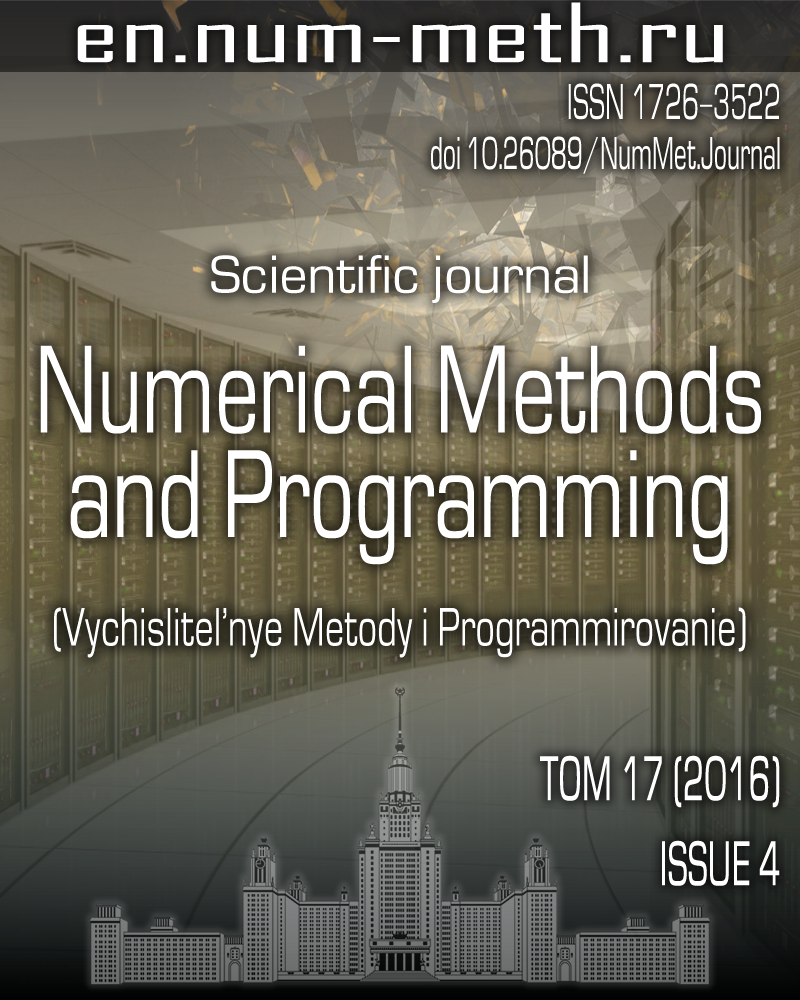DOI: https://doi.org/10.26089/NumMet.v17r438
On a problem of the synthesis of binary nano-optical elements
Keywords:
Abstract
This paper deals with optical security label identification technology as a part of augmented reality technology. Security labels are based on binary nanooptical elements and are photographed using a smartphone. Photographed images are interpreted as diffractive optical elements. Optical images formed by these diffractive elements are computed using the Fresnel approximation. These images are used to identify the security labels. A security label consists of a phase optical element whose microrelief height is of no more than 0.5 mkm. Nanooptical elements are manufactured using electron-beam lithography. The optical security labels are resistant against microrelief damages and can withstand partial loss of an image. The optical elements developed can be used to protect and identify banknotes, documents, etc.
Published
Issue
Section
References
- An. Firsov, A. Firsov, B. Loechel, et al., “Fabrication of Digital Rainbow Holograms and 3-D Imaging Using SEM Based E-Beam Lithography.’’ Opt. Express. 22 (23), 28756-28770 (2014).
- Y. Sheng and J. Wang, “Binary Hologram of Very Large Space Bandwidth Product Designed by the Genetic Algorithm,” Digital Holography & 3-D Imaging Meeting, OSA Technical Digest (2015).
doi 10.1364/DH.2015.DM4A.3 - P. Rai-Choudhury (Ed.), Handbook of Microlithography, Micromachining, and Microfabrication , Vol. 1: Microlithography (SPIE Press, Bellingham, 1997).
- R. L. van Renesse, Optical Document Security (Artech House, Boston, 1998).
- A. Goncharsky, A. Goncharsky, and S. Durlevich, “Diffractive Optical Element for Creating Visual 3D Images,” Opt. Express 24 (9). 9140-9148 (2016).
- A. Goncharsky, A. Goncharsky, and S. Durlevich, “Diffractive Optical Element with Asymmetric Microrelief for Creating Visual Security Features,” Opt. Express 23 (22). 29184-29192 (2015).
- A. A. Goncharsky and S. R. Durlevich, “A Problem of Synthesis of Nano-Optical Elements for the Formation of Dynamic Images,” Vychisl. Metody Programm. 14, 343-347 (2013).
- A. A. Goncharsky, “On the Problem of Synthesis of Nano-Optical Elements,” Vychisl. Metody Programm. 9, 405-408 (2008).
- M. Aleksy, E. Vartiainen, V. Domova, and M. Naedele, “Augmented Reality for Improved Service Delivery,” in Proc. IEEE 28th Int. Conf. on Advanced Information Networking and Applications, Victoria, Canada, May 13-16, 2014 (IEEE Press, Washington, DC, 2014), pp. 382-389.
- F. Belloni and S. Monneret, “Quadrant Kinoform: An Approach to Multiplane Dynamic Three-Dimensional Holographic Trapping,” Appl. Opt. 46 (21), 4587-4593 (2007).
- P. Karvinen, D. Grolimund, M. Willimann, et al., “Kinoform Diffractive Lenses for Efficient Nano-Focusing of Hard X-Rays,” Opt. Express 22 (14), 16676-16685 (2014).
- H. Zhang, H. Liu, Z. Lu, and H. Zhang, “Modified Phase Function Model for Kinoform Lenses,” Appl. Opt. 47 (22), 4055-4060 (2008).
- T. R. M. Sales and G. M. Morris, “Diffractive-Refractive Behavior of Kinoform Lenses,” Appl. Opt. 36 (1), 253-257 (1997).
- K. J. Moh, X.-C. Yuan, W. C. Cheong, et al., “High-Power Efficient Multiple Optical Vortices in a Single Beam Generated by a Kinoform-Type Spiral Phase Plate,” Appl. Opt. 45 (6), 1153-1161 (2006).
- X.-C. Yuan, B. P. S. Ahluwalia, W. C. Cheong, et al., “Direct Electron Beam Writing of Kinoform Micro-Axicon for Generation of Propagation-Invariant Beams with Long Non-Diffracting Distance,” J. Opt. A: Pure Appl. Opt. 9, 329-334 (2007).
- L. B. Lesem, P. M. Hirsch, and J. A. Jordan, “The Kinoform: A New Wave-Front Reconstruction Device,” IBM J. Res. Dev. 13, 105-155 (1969).
- A. V. Goncharsky and A. A. Goncharsky, Computer Optics and Computer Holography (Mosk. Gos. Univ., Moscow, 2004) [in Russian].
- Q. Tan, Y. Yan, G. Jin, and D. Xu, “Fine Design of Diffractive Optical Element for Beam Transform,” Proc. SPIE 4443, 184-188 (2001).
doi 10.1117/12.446750 - J. R. Fienup, “Phase Retrieval Algorithms: A Comparison,” Appl. Opt. 21 (15), 2758-2769 (1982).
- F. Mohammad, J. Anarase, M. Shingote, and P. Ghanwat, “Optical Character Recognition Implementation Using Pattern Matching,” Int. J. Comput. Sci. Inform. Technol. 5 (2), 2088-2090 (2014).
- A. F. Mollah, N. Majumder, S. Basu, and M. Nasipuri, “Design of an Optical Character Recognition System for Camera-Based Handheld Devices,” Int. J. Comput. Sci. Iss. 8 (4), 283-289 (2011).
- D. G. Lowe, “Distinctive Image Features from Scale-Invariant Keypoints,” Int. J. Comput. Vis. 60 (2), 91-110 (2004).


